skip to main |
skip to sidebar
Tuesday 25th September 2018
It's an interesting experience sleeping on a train parked in the railway station of the capital city of a country. I slept well in our train parked in platform 4 of Tbilisi station and enjoyed the experience. Breakfast was served from 7.30 to 9.00 a.m. and I allowed a little time for observing the train movements at this busy station.
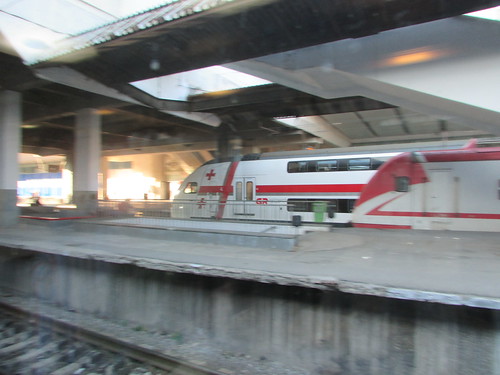
Tbilisi Station, Georgian Railway: Two imported modern Electric Multiple Units, one double-decked.
Just after nine, we all met on the platform and made our way to the coaches waiting outside the station. We'd been offered a choice of tours - I'd elected for the one outlined below and it proved a good choice.
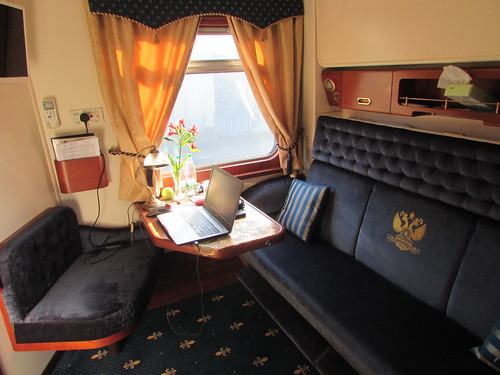
The 'Golden Eagle' Train: Cabin in 'Day Mode', set up for working on my laptop computer.
The coaches took about two hours to reach our first destination - the Tsinandali Estate in the wine-making area of Eastern Georgia, Kakheti. The estate comprises a garden, park and former family home of Prince Alexander Chavchavadze (1786-1846) now turned into a museum with furnishings and effects either from the Chavchavadze family or similar. We had an interesting conducted tour of the house but I'm afraid photography was not allowed inside. There's a website here.
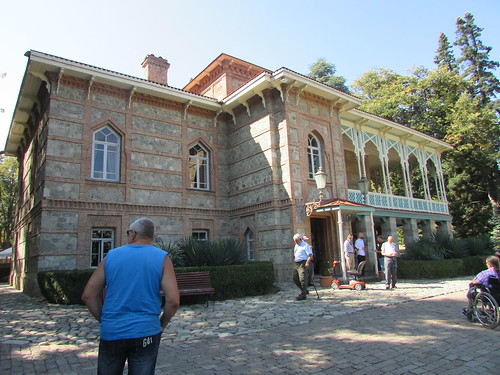
Tsinandali Estate, Kakheti, East Georgia
The coaches then drove us to Mosmieri's Winery, a modern establishment producing red and white wine using 'European' methods. One side of the factory building was glazed, allowing us to view the massive, gleaming tanks in which fermentation occurs. The winery also produces an 'amber' wine using the traditional 'Georgian' method. Normal white grapes are used but fermentation takes place in a number of large clay pots called 'Kvevri' similar to a Roman amphora, which are mounted underground and sealed. In this method, grape skins are also used in fermentation, producing a potent wine (around 13% proof).
There are interesting articles on Wikipedia on Georgian Winemaking and Kvevri (with yet further links for the oenophile). To make the Mosmieri Wine Centre a suitable destination for general tourists, wine tasting for parties is offered, followed by a Georgian-style lunch.
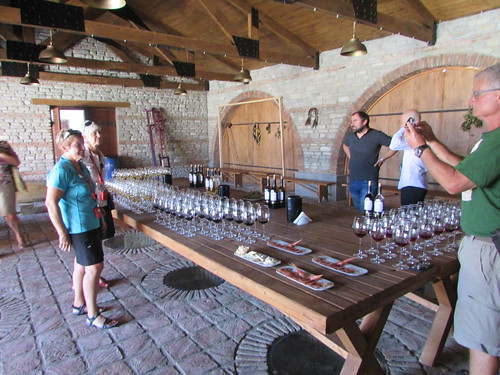
Wine tasting at Mosmieri Wine Centre, East Georgia.
After tasting the three varieties of wine produced there was, as you may imagine, a very merry lunch. The Mosmieri Wine Centre has a web site here.
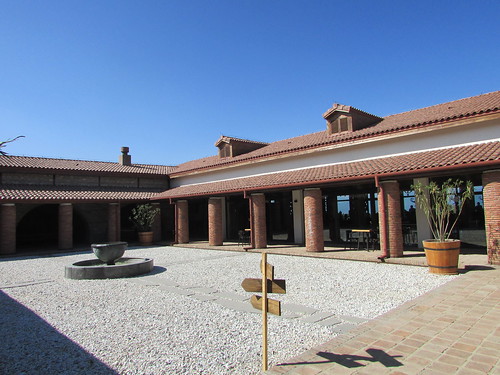
The Restaurant at Mosmieri Wine Centre, East Georgia
We then drove to Signagi Royal Town and our briefing notes promised "breathtaking views of Kizikhi area". We stopped to walk around Sighnaghi Old Town. The briefing notes offered a "walk in narrow streets of the town in shadow of wooden balconies richly decorated with the lace of carved ornaments". They didn't mention the steepness of the cobbled streets but, despite that, I made it to a brick viewpoint tower built on the remains of an old church and battlements from which the views were, indeed, stunning.
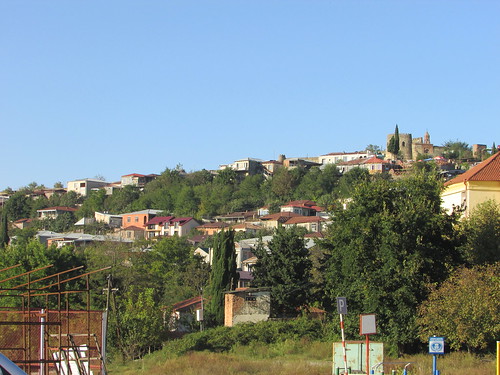
Signagi Royal Town, Kizikhi, Georgia: View of the town from the car park where our coaches stopped. The brick viewpoint I walked to can be seen top right, built on stone battlements.
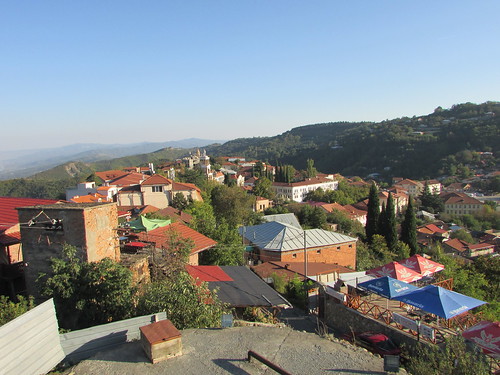
Signagi Royal Town, Kizikhi, Georgia: Looking across the town from the brick viewpoint.
With everyone safely back on the coaches, it took over two and a half hours to drive back to Tbilisi and our waiting train but we had all enjoyed the visits during the day and the weather had remained sunny and hot.
Related posts on this website
This is one of a series of posts describing my 'Golden Eagle' Caspian Odyssey trip, starting with Travelling East.
Clicking on the 'Next report' link displays the post describing the next events. In this way, you may read about the trip in sequence.
Next report
Alternately, clicking on the 'All my Caspian Odyssey reports' link displays all the posts on this trip in reverse date-of-posting order.
All my Caspian Odyssey reports.
My pictures
The 'Golden Eagle' Train from Yerevan.
Tbilisi, Georgia.
Tsinandali Estate, Georgia.
Kakheti Vineyards and Mosmieri Wine Centre, East Georgia.
Signagi Royal Town, Kizikhi, Georgia
All my pictures taken in Georgia are in the collection Georgia.
[Signagi description corrected 4-Oct-2018: Links to pictures added 6-Oct-2018: Pictures embedded 24/25-Oct-2018: Winemaking references added 27-Oct-2018]
Monday 24th September 2018
I was already up when we arrived at Ayrum around 7.00 a.m. where Armenian customs formalities would take place. Crossing international borders is a serious business and our daily briefing notes to passengers asked us to wait in our cabin while customs officials went through the train. I noticed unthreatening-looking soldiers at regular intervals on the non-platform side of the train. The actual 'Exit' stamp was applied by a friendly, polite immigration official in the doorway of my cabin, after he checked a small laptop.
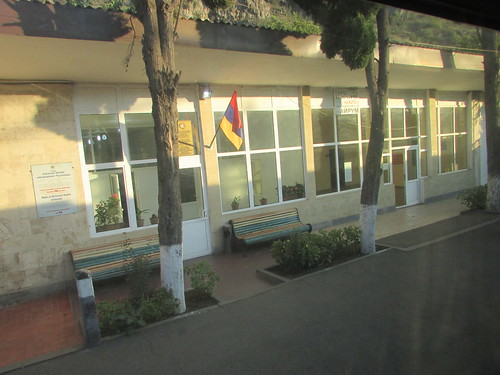
Armenia Railways: The well-kept station at Ayrum.
As each coach was completed, we were invited to go to the restaurant car for breakfast. The train set off again just before eight o'clock and arrived at Sadakhio about 8.20 a.m., presumably having crossed the legal border somewhere between the two stations.
As we arrived, there were no soldiers on security duties (at least, none visible) but I noticed a Georgian railways electric locomotive on the adjacent track which I correctly guessed would replace the Armenian locomotive which had brought us from Yerevan.
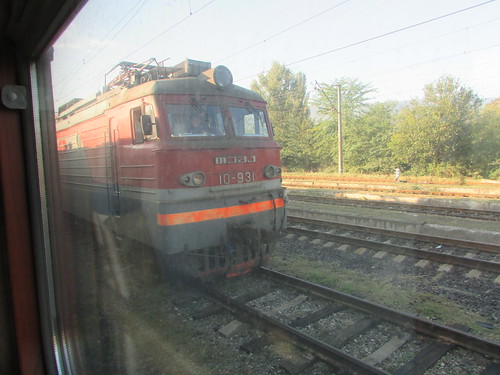
Sadakhio, Georgian Railway electric locomotive 10-931 (class VL10).
Once again, we were asked to remain in our cabin until formalities were complete. A party of three officials walked through the train and the senior one checked my appearance with my passport photograph before adding the passport to a substantial pile he'd already gathered. Within 15 minutes, the senior man returned and handed me my stamped passport. I was now in Georgia which, like Armenia, does not require a visa for British passport holders.
At 09:20, as scheduled, we were on the move again on the single line which would take us to the capital of Georgia, Tbilisi. It was a little after eleven when we arrived in platform 1 of Tbilisi station. The architecture of the station is modern and functional but already in need of significant renovation because of crumbling concrete.
Within minutes, we were making our way through the busy station to the road coaches for our city tour. Although independence has brought many problems, Georgia has been successful in attracting inward investment and the city now has a number of striking new buildings. As in many countries, the capital has acted as a magnet and migration from country districts means that around half of Georgia's population now live in Tbilisi. One consequence is congestion on the city's roads and it took our coach some time to drive perhaps two kilometres from the station to the Old City from where we continued on foot.
Firstly, we visited the Metechi Church with its two separate bell towers. This dates from the 12th century and formed part of the former royal residential complex.
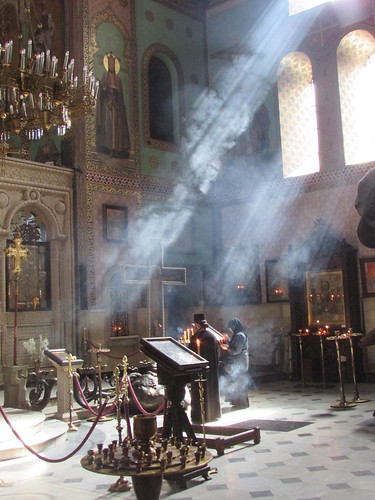
Tbilisi, Georgia: Inside the Metechi Church as a devotion is performed, amidst clouds of incense.
Our guide, Dimitri, then led us down the narrow streets (now lined with restaurants), calling in to see the remodelled 17th century caravanserai. I knew the term as applied to a group of travellers, often traders, negotiating the great trade routes but the term also applies to the periodic stopping places, sometimes elaborate, where travellers could be accommodated.
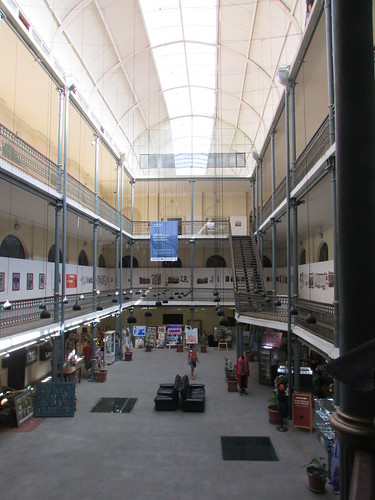
Tbilisi, Georgia: Restored 17th century Caravanserai.
Crossing the nearby main road proved rather hairy, then our guide led us at high speed across the river bridge and up awkward steps to the Sioni Cathedral which was started in the 7th century.
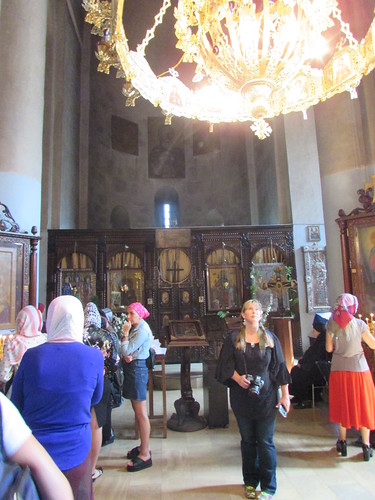
Tbilisi, Georgia: Inside Sioni Cathedral.
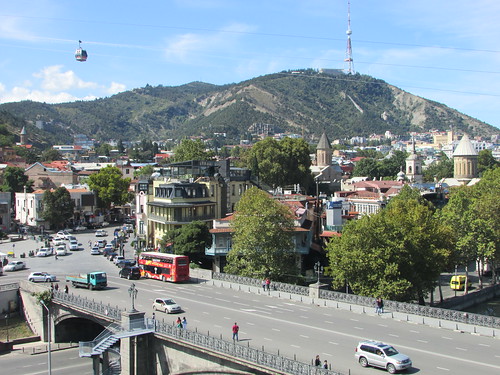
View of Tbilisi, Georgia, from outside Sioni Cathedral.
Crossing back over the main road, we walked to the district with a number of bathhouses using local water which contains sulphur for which, apparently, Tbilisi is famous. We saw (from outside only) one Muslim-style and a number of Turkish-style bathhouses. The Turkish baths are subterranean, with only stone domes of various sizes showing above ground, reminding me of a some of the Star Wars sets showing desert villages.
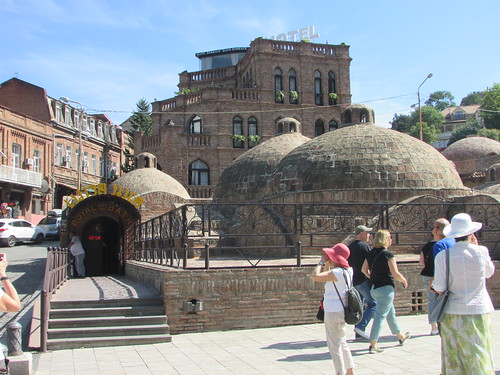
Turkish-style Sulphur Bathhouses in Tblisi, Georgia
We took lunch in the large private dining room of a nearby restaurant. Naturally, it was upstairs (this isn't a just pattern - it's a conspiracy to show up my impaired mobility). The food was Georgian style and I've decided that I'd probably survive on Armenian/Georgian food although I'm noted for my limited food preferences. After a jolly, but noisy, meal we joined our coaches on the busy main road and were driven through the seemingly perpetual traffic jam in Tbilisi to the Janashia State Museum.
The Museum was opened specially for our tour to have a viewing of the 'Golden Treasury' exhibition. Research has shown Georgia to be one of the earliest sites of human development after Africa and the discovery of a large collection of gold and silver articles of early date and astonishing sophistication forms the basis of this remarkable exhibition.
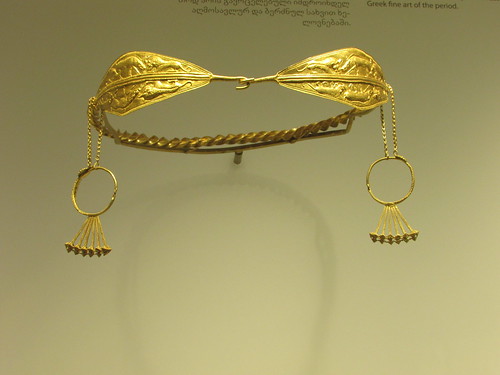
Janashia State Museum, Tbilisi, Georgia: Gold Diadem with rhomboid plaques depicting fighting animals - a recurrent theme in Eastern and Greek fine-art of the period.
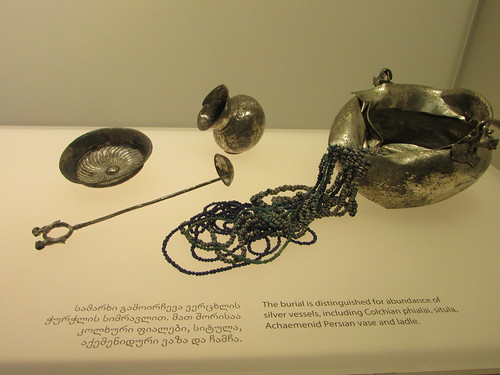
Janashia State Museum, Tbilisi, Georgia: Silver vessels, including Colchian phialai, situla, Achaemenid Persian vase and ladle were found in this burial.
Our bus struggled through the traffic again to return us to our train, now moved to platform 4, allowing guests time for a brief rest before going out to dinner at a local restaurant by coach.
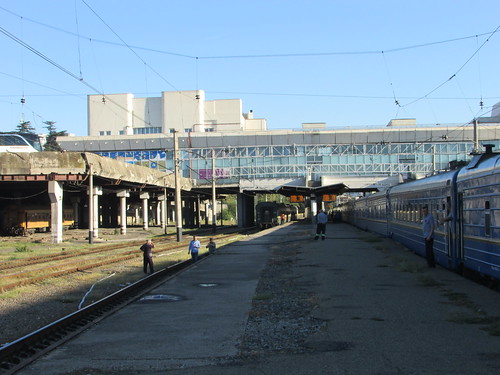
Tbilisi Station, with the 'Golden Eagle' train in platform 4.
The popular Georgian Restaurant at the head of a wide, sweeping staircase, was a huge room with a large number of big round tables accommodating, I should think, a few hundred diners. The meal was Georgian style with lots of items in generous proportions. The meal was accompanied by music and dance, the music played very loud and with synchronised lighting effects. There was a pianist, two male vocalists, one female vocalist (all performing modern 'standards') and an amazing troupe of Georgian dancers.
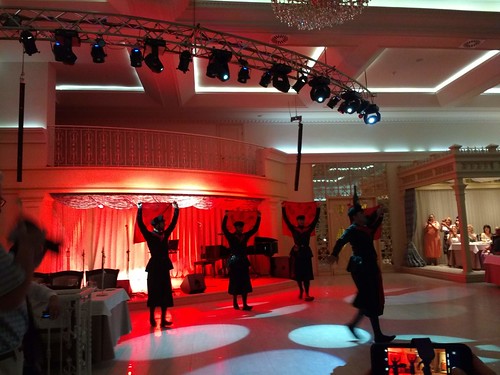
Dinner in Tbilisi: The Georgian Dancers.
After the meal and the entertainment, we made our way outside to where our coaches waited in the darkness. Once back at Tbilisi station, a walk through the brightly-lit and still fairly busy concourse led down to platform 4 and my welcome cabin on the 'Golden Eagle'.
Related posts on this website
This is one of a series of posts describing my 'Golden Eagle' Caspian Odyssey trip, starting with Travelling East.
Clicking on the 'Next report' link displays the post describing the next events. In this way, you may read about the trip in sequence.
Next report
Alternately, clicking on the 'All my Caspian Odyssey reports' link displays all the posts on this trip in reverse date-of-posting order.
All my Caspian Odyssey reports.
My pictures
These albums include pictures of the above events:-
The 'Golden Eagle' Train from Yerevan.
Railways in Armenia.
Georgian Railway.
Tbilisi Station, Georgian Railway.
Tbilisi, Georgia.
Janashia State Museum, Tbilisi, Georgia.
Dinner in Tbilisi, Georgia.
All my pictures taken in Georgia (except 'technical' railway pictures) are in the collection Georgia.
[Minor edits, links to pictures added 6-Oct-2018: Pictures embedded 22/23-Oct-2018]


















